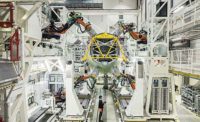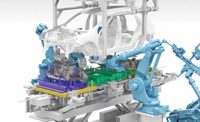Five Things: Automatic Screwdriving








1. Robot Installs Clips in Auto Parts
Visumatic Industrial Products has built a robotic cell for installing clips in large automotive parts. The cell includes a four-axis SCARA robot with an 800-millimeter reach, a tooling plate, vision inspection, and an automatic feeder and insertion spindle.
The plate is on a slide so the operator can load parts ergonomically. When the cell is actuated, the slide carries the part into the work area. Fixtures are located on the plate with pins to simplify changeover. Clamps secure the part during installation.
Visumatic’s VIM 700 clip insertion spindle is mounted to the robot’s quill. The feed system includes a hopper, vibratory bowl and escapement. The hopper keeps the bowl filled at the optimal level.
The HMI displays a model of the part with each insertion point. During installation, each point is illuminated green for a good insertion, yellow for an error, or red for a bad insertion.
2. Automatic Screwdriver Still Going After 37 Years
Based in Buchenbach, Germany, Siko GmbH makes mechanical and electronic devices for measuring length, angle and speed. One of the company’s products is a handwheel equipped with analog position indicators. The handwheel’s scale and mechanics are attached with two screws. Initially, the screws were installed by hand. But, as demand increased, the company opted to automate the process in 1983 with an automatic screwdriver from Weber Screwdriving Systems. Some 37 years later, the machine is still installing screws.
“It does what it should. It works—and after all, a machine has to,” says Ralf Mäder, production foreman at Siko, who estimates the machine has installed almost 3 million screws to date.
3. Robotic Screwdriving System Assembles Auto Part
Nitto Seiko America has supplied a SR565YΘ-Z robotic screwdriving system for an automotive HVAC application. The robot’s Y axis is 500 millimeters. The Θ axis has a 300-millimeter radius and can pivot 180 degrees. The Z axis is 400 millimeters. The robot’s work envelope is 500 by 600 millimeters.
The screwdriver is blow-fed. A trace-and-purge system tracks the screw from the feeder to the end of the chuck. Vacuum keeps the screw on the bit, so fasteners can be installed in locations just 1 millimeter larger than the diameter of the screw head. If an error occurs while driving, the vacuum removes the screw from the part.
4. Robot Drives 300 Screws
Distributor and machine builder Flexible Assembly Systems Inc. of San Diego has built a robotic screwdriving system. The system features a FANUC LR mate 200id six-axis robot equipped with an Atlas Copco Micro Torque screwdriver. The system installs 300 screws on each part. The system also includes an automatic dispensing unit to apply a threadlocker when needed.
5. Design Tool Inc.
Design Tool Inc. has built a machine that automatically drives six screws simultaneously. Two feeder bowls supply six screwdrivers, which are mounted to a gantry system that moves the tools up and down at the same time.
Looking for a reprint of this article?
From high-res PDFs to custom plaques, order your copy today!










